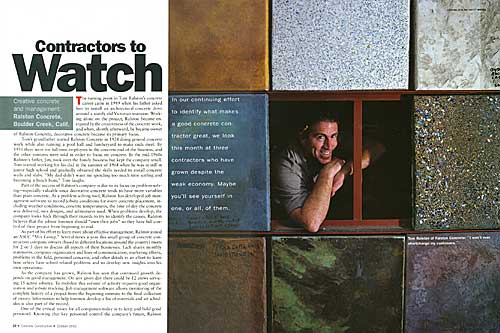Contractors to Watch
In our continuing effort to identify what makes a good concrete con tractor great, we look this month at three contractors who have grown despite the weak economy. Maybe you'll see yourself in one, or all, of them.


The turning point in Tom Ralston's concrete career came in 1989 when his father asked him to install an architectural concrete drive around a stately old Victorian mansion. Working alone on the project, Ralston became energized by the creativeness of the concrete work, and when, shortly afterward, he became owner of Ralston Concrete, decorative concrete became its primary focus.
Tom's grandfather started Ralston Concrete in 1928 doing general concrete work while also running a pool hall and lumberyard to make ends meet. By 1950 there were ten full-time employees in the concrete end of the business, and the other ventures were sold in order to focus on concrete. In the mid-1960s Ralston's father, Jim, took over the family business but kept the company small. Tom started working for his dad in the summer of 1964 when he was in still in junior high school and gradually obtained the skills needed to install concrete walls and slabs. "My dad didn't want me spending too much time surfing and becoming a beach bum," Tom laughs.

Tom Ralston of Ralston Concrete: "I won't ever shortchange my customers."
Part of the success of Ralston's company is due to its focus on problem-solving --especially valuable since decorative concrete tends to have more variables than plain concrete. As a problem-solving tool, Ralston has developed job management software to record jobsite conditions for every concrete placement, including weather conditions, concrete temperatures, the time of day the concrete was delivered, mix designs, and admixtures used. When problems develop, the company looks back through their records to try to identify the causes. Ralston believes that the jobsite foremen should "own their jobs" so they have full control of their project from beginning to end.
As part of his effort to learn more about effective management, Ralston joined an ASCC "Mix Group." Several times a year this small group of concrete construction company owners (based in different locations around the country) meets for 2 or 3 days to discuss all aspects of their businesses. Each shares monthly statements, company organization and lines of communication, marketing efforts, problems in the field, personnel concerns, and other details in an effort to learn how others have solved related problems and to develop new insights into his own operations.
As the company has grown, Ralston has seen that continued growth depends on good management. On any given day there could be 12 crews servicing 15 active jobsites. To mobilize this volume of activity requires good organization and jobsite tracking. job management software allows monitoring of the complete history of a project from the beginning estimate to the final collection of money. Information to help foremen develop a list of materials and set schedules is also part of the record.
One Of the critical issues for all companies today is to keep and hold good personnel. Knowing that key personnel control the company's future, Ralston promotes a collective effort in company decisions. Given the current growth rate, Ralston is firmly convinced that continued success is tied to keeping the quality of his product high, and toward that end he will only follow specifications and select materials that enhance the quality of his installations, noting that "I won't ever shortchange my customers."
Page 32 > Concrete Construction > October 2002
